Day 3 of a three day long weekend of Late Winter Birding tours today, our last day and we made our way down to the Brecks. This was forecast to be the best day of the weekend, but after better than expected weather on Friday and Saturday, it remained stubbornly cloudy through the day today. Still, we made the best of it and managed to see all the specialities we were looking for. After the drive down to the Brecks, we regrouped in Swaffham (so members of the group could make a quick getaway at the end of the day) and set off to explore the forest.
Our first stop saw us at a site from which we could overlook the forest. We were just setting the scope up and the first bird we saw as we lined it up on the trees was a Goshawk. It was just a glimpse between the tops of trees. We expected it to circle up above the canopy, but it but didn’t. A few seconds later another local standing nearby asked ‘is that a Buzzard in the tree’, but as we swung the scope onto it, we could see that it was a juvenile Goshawk, perched in the top of a fir tree. It was obviously huge, very brown-toned above and spotted with pale feathers (the adults are grey above). Unfortunately it quickly dropped down again into the trees, before the whole of group could get a look at it through the scope.
Encouraged by our early Goshawk sighting, we waited for a reappearance. With the low cloud today, and cool conditions, there was less raptor activity in terms of numbers but still we saw a great variety. The Common Buzzards were coming and going all the time, though not circling up high into the sky. A rather pale bird caught the eye on a couple of occasions – Common Buzzards are very variable and there are some very white birds around. A Kestrel perched on a post. A Sparrowhawk circled up, and was pursued by a pair of Crows. Even a Peregrine put in a brief appearance, circling over behind us before disappearing behind the trees. But there was no more sign of Goshawk.
There were other things to see while we waited. A large flock of Redwings flew up and perched in the top of the trees, before flying down to the field below. Through the scope we could see their prominent pale superciliums. A large bare tree over the other side held four thrushes – two Mistle Thrushes, a Fieldfare and another Redwing. A little later, one of the Mistle Thrushes started singing. There were several Skylarks around and they were singing despite the cool weather. A couple of Yellowhammers flew round in front of us calling. A flock of Linnets whirled over the field periodically.
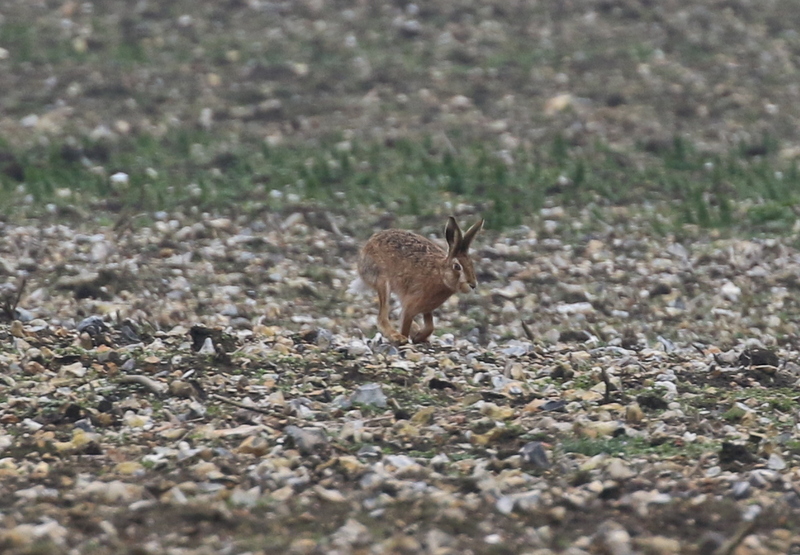 Brown Hare – we watched a couple of pairs chasing round the fields
Brown Hare – we watched a couple of pairs chasing round the fields
There was one pair of Brown Hares each side of us in the fields. They spent a lot of time just feeding, but we did watch one pair as the male chased the female in circles for a while. She didn’t turn round and ‘box’ him though, unfortunately. He seemed to lose interest fairly quickly and they resumed feeding.
Eventually we could see some brighter weather approaching from west. The sun just poked out from behind clouds, enough to light up the trees in front of us. More Common Buzzards circled up, gaining a little more height too than they had all morning. Finally the juvenile Goshawk appeared again, flying low across over the tops of the trees. As we watched it, we could see see why – an adult Goshawk was chasing it, silvery grey above and gleaming white below in the sunshine.
The two Goshawks flew across the length of the line of trees in front of us and disappeared into the wood in the corner. All the Woodpigeons scattered from the wood as they flew in. A short while later, the adult Goshawk flew back again low over the trees, across to where it had come from. Presumably it felt it had achieved its mission, chasing off the youngster.
Then the juvenile Goshawk started to drift back too. It circled up out of the trees, giving us a chance to get it in the scope and everyone managed to get a look at it. The upperparts were brown and the black-streaked apricot toned underparts caught the sun. Then it dropped down behind the trees again and we decided to move on.
Our next stop was at St Helens picnic site. As we drove in, we could see some Bramblings on the ground among the leaves. There were a lot of cars here today, so it was obviously rather disturbed and the Bramblings were very flighty. As we got out of the car, the last of them flew up into the trees, and they gradually started to fly off calling. We drove round to the other side of the car park to see if they had landed over there, but when we came back round we found a good number of them had landed again back where they had been at first.
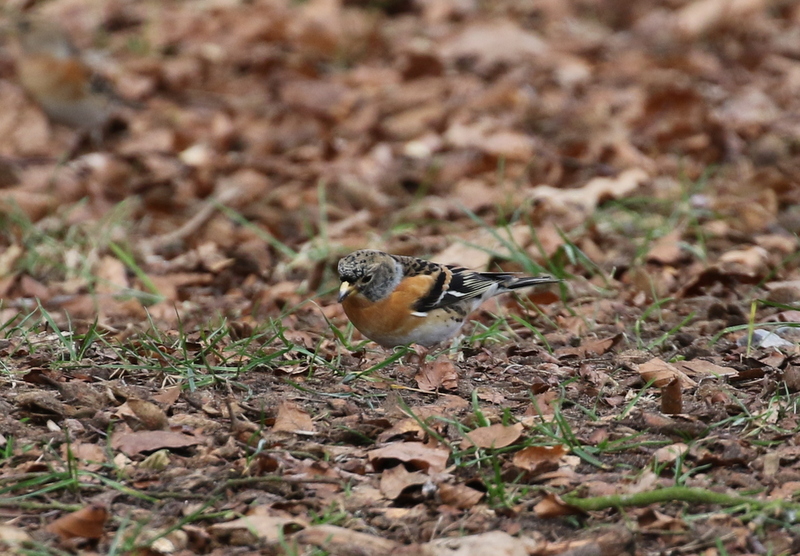 Brambling – a bright male, with only limited black visible on its head
Brambling – a bright male, with only limited black visible on its head
By carefully positioning the car, we had nice views of the Bramblings feeding on the beech mast. They were very hard to see among the orange leaves, but there were at least 20 of them still. The brighter males were noticeably variable, with some already getting blacker heads.
After watching the Bramblings for a while, we drove over to Santon Downham for an early lunch. A Greenfinch was singing from the birches in the car park. A Goldcrest was flitting around in a fir tree singing and we could hear a Marsh Tit singing nearby. Spring was obviously in the air! There were more Bramblings here too, dropping down out of the taller trees into the gardens.
After lunch, we drove deeper into the Forest.We parked up and walked down a ride to a large clearing. It is normally very quiet here, but just as we arrived at the clearing we met a dog walker coming the other way. We were hoping to find a Woodlark here, but with the dogs having just gone through their favoured area, we thought we might be out of luck. However, as we turned the corner two Woodlarks flew up in front of us.
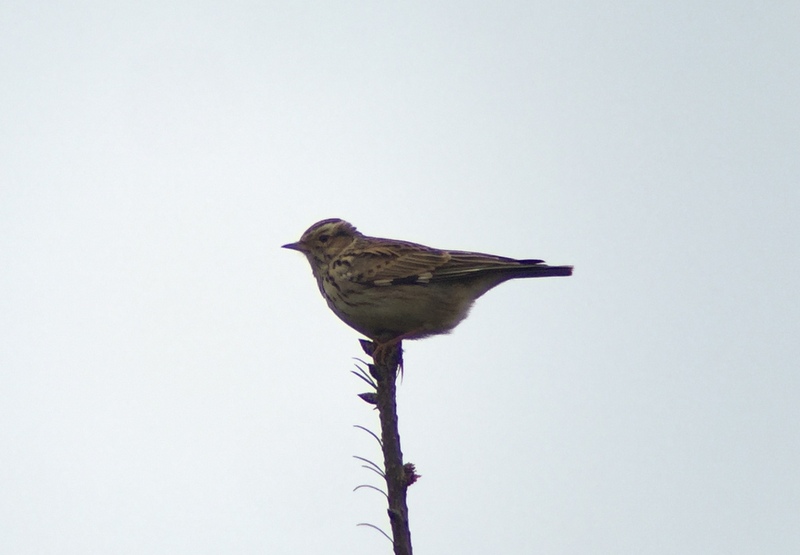 Woodlark – dropped down into the top of a fir tree
Woodlark – dropped down into the top of a fir tree
The Woodlarks started singing, a much more melancholy song than a Skylark. They fluttered up, gaining height, but then flew round, song flighting over the clearing. One then dropped down and landed in the top of a fir tree out in the middle, where we could get it in the scope. We had a great view of it, the bright rusty ear coverts, the well-marked supercilia meeting on the back of the nape in a shallow ‘v’. Eventually it dropped down onto an open patch of ground, but still managed to disappear into the low vegetation.
We were just looking for the Woodlark, when we heard the faint ‘glip, glip’ call of a Common Crossbill. They are often to be heard flying over here, but when the calls were repeated they seemed to be coming from the same place. We scanned across the tops of the trees and could see a Crossbill perched up partly obscured, in the bare branches in the top of a deciduous tree. We repositioned ourselves for a clearer line of sight and got it in the scope.
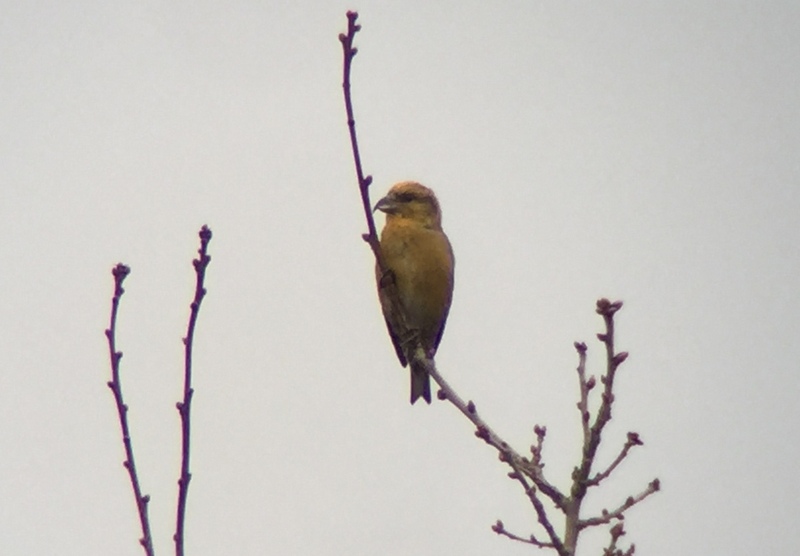 Crossbill – a male perched nicely for us in the top of a tree
Crossbill – a male perched nicely for us in the top of a tree
The Crossbill was a male – we could see its rusty orange overall colour. Through the scope, we could also see its distinctive crossed mandibles. Its throat feathers were moving and it appeared to be singing quietly, although we couldn’t hear it from where we were standing. Then it dropped back into the trees and disappeared.
Our main target for the afternoon was Hawfinch, and it was now time for us to get back to Lynford to await their arrival. As we walked down the path beside the Arboretum, we stopped by the feeders. There were lots of Bramblings in the leaves, along with several Chaffinches, but they were very hard to see. They were very well camouflaged, but they were throwing beak-fulls of leaves up in the air to look for beech mast, which rather gave their presence away. It was funny to watch too!
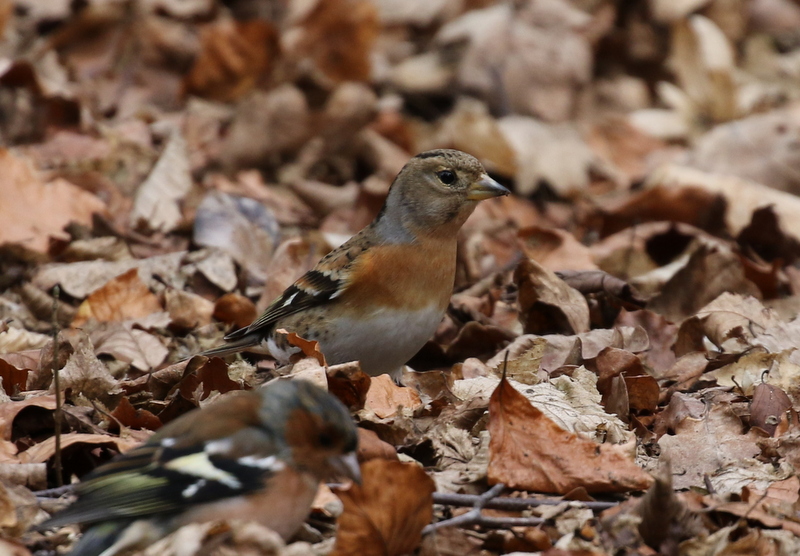 Brambling – a female in the leaves, Chaffinch in the foreground
Brambling – a female in the leaves, Chaffinch in the foreground
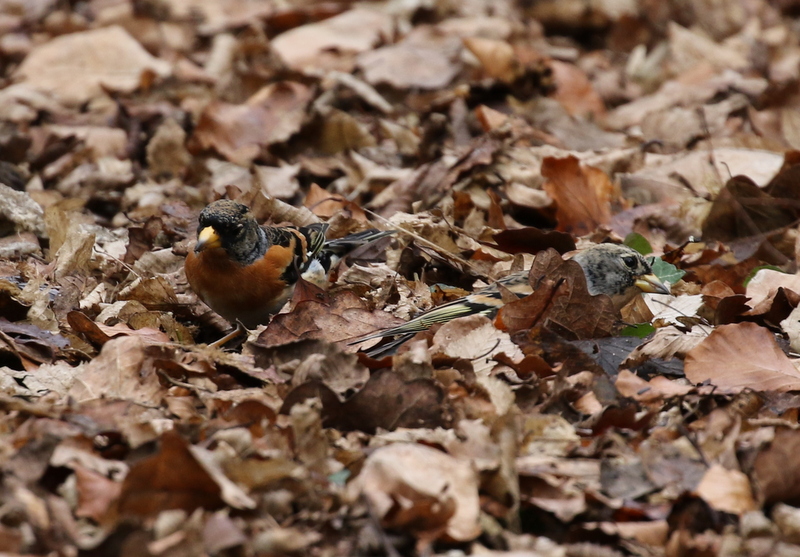 Bramblings – two males in the leaves, with different degrees of black heads
Bramblings – two males in the leaves, with different degrees of black heads
Down at the bridge, there was lots of seed which had been put out. A steady stream of tits were coming down to feed, mostly Blue Tits and Long-tailed Tits but also a few Great Tits and a Coal Tit. A single Marsh Tit kept darting in, grabbing some seed, and flying back in the bushes to eat it. Overhead, we could hear a cacophony of twittering from all the Siskins in the top of the trees.
 Marsh Tit – kept darting in to grab some seed from the bridge
Marsh Tit – kept darting in to grab some seed from the bridge
Then it was time to look for the Hawfinches. As we made our way along the side of the paddock, we could already see two distantly in the tree tops behind. We had a quick look through the scope, just to make sure everyone had seen them, and then walked round further for a better view. There were several Hawfinches now, singles or pairs in different trees, and they kept flying between the tops. We spent some time watching them, admiring their large powerful bills, big heads and short tails.
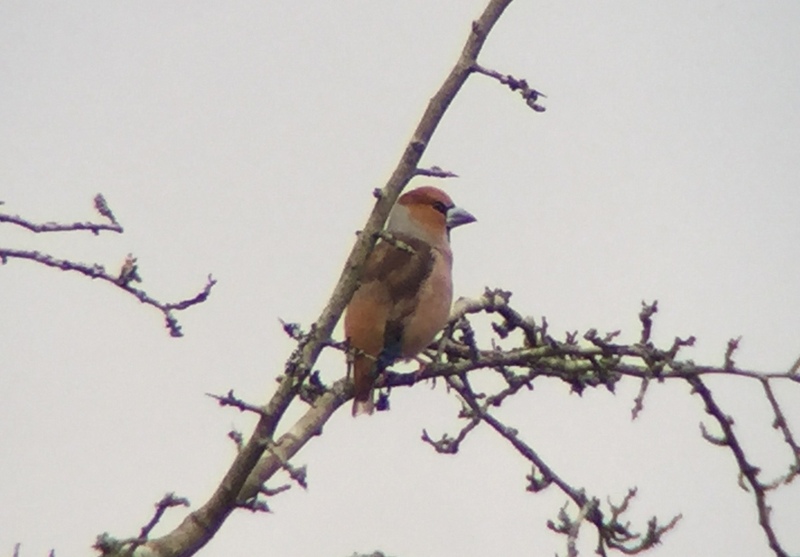 Hawfinch – several flew down to the trees in the paddocks
Hawfinch – several flew down to the trees in the paddocks
Suddenly, several Hawfinches all flew out of the trees together. A couple flew off, but most dropped down into the trees in the paddocks. Here we got much better views of them, low down and not against the brighter sky. After a short while, most of the Hawfinches seemed to make their way back up into the pines. When they all flew round again, it looked like there were around 15 Hawfinches here today. This was not quite as many as recent days, but having enjoyed very good views of them, we started to walk back, perhaps before they were all in.
As we made our way back around the paddocks, a few people were staring up into the pines on the other side. A pair of Common Crossbills were in a small tree by the side of the path. The male was harder to see in the branches at the back, but we had a great view of the female as she tucked into a pine cone. After working her way round it for a while, pulling it open and taking out the seeds, she dropped the cone and had a quick stretch and preen. Then the pair of Crossbills both flew off over the path calling.
 Common Crossbill – the female tucking into a pine cone
Common Crossbill – the female tucking into a pine cone
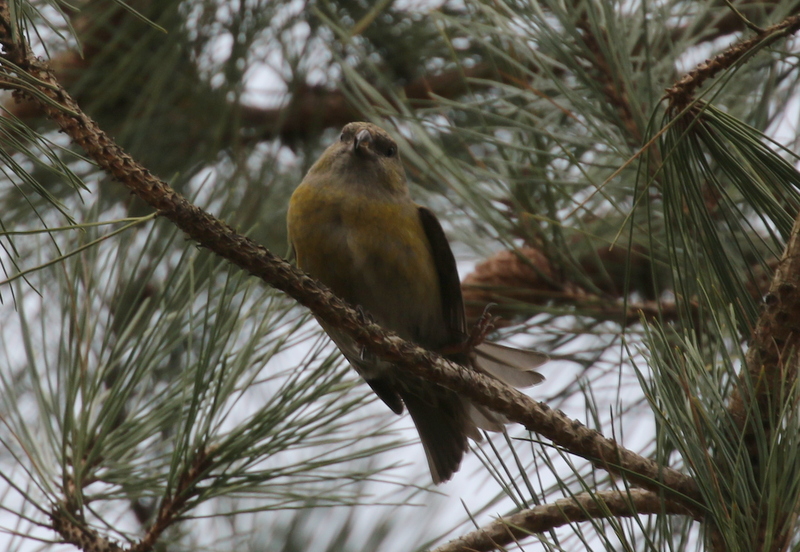 Common Crossbill – the female having a stretch afterwards
Common Crossbill – the female having a stretch afterwards
We continued up past the car park to the old gravel pits beyond. We had hoped to see a Goosander but we were informed when we arrived that they had just flown off, unfortunately. We did manage to find a single drake Goldeneye, a few Tufted Ducks and a couple of Great Crested Grebes. We were just about to give up, when a pair of Mandarin appeared out from behind the overhanging trees. They were followed by a pair of Mallard and the two drakes then had a brief altercation before the pair of Mandarin flew off.
 Mandarin – this pair were on the gravel pits at Lynford
Mandarin – this pair were on the gravel pits at Lynford
It was time to head back, but we still had one surprise in store. As we drove into Swaffham, we could see a flock of Starlings circling over the houses. By the time we got back to the car park, there were already several thousand overhead and more were coming in all the time from different directions. Several hundred tried to go down into a fir tree earlier than the rest, but they were clearly nervous and promptly took off again.
The Starling murmuration grew and grew, probably numbering over 20,000 birds at its peak. They all flew round overhead for about half hour, twisting and turning, quite an amazing sight. Then suddenly they started to drop down into the trees. They descended in several different places, but a large number went into a couple of holly trees nearby. It was fascinating to watch – when a group decided they were going in to roost, they dropped out of the sky at speed and went hurtling into their chosen tree, disappearing completely from view. Hundreds and hundreds all went into a single small tree.

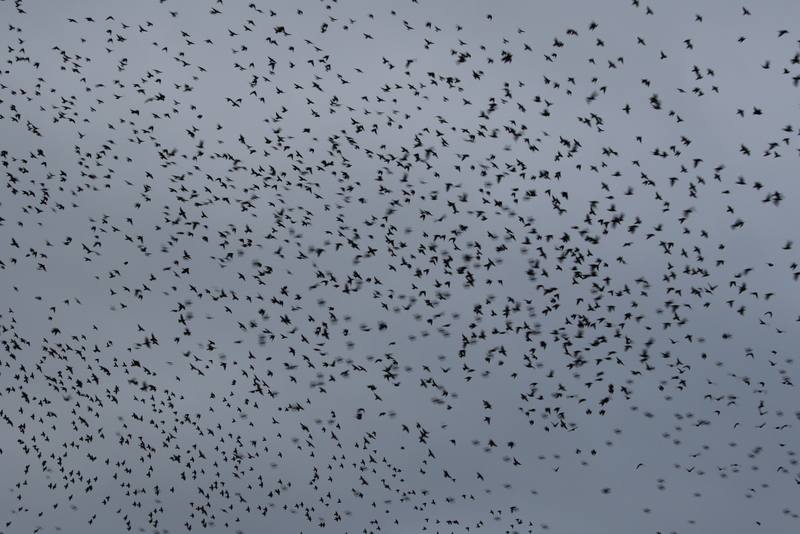 Starlings – the murmuration at the end of the day was quite a sight
Starlings – the murmuration at the end of the day was quite a sight
Once they had decided to go to roost, within just a few minutes all the Starlings had gone. We still could hear them though, even if we couldn’t see them, their noisy chattering coming from the trees all around. It was a stunning sight, and a great way to end three exciting days of winter birding.
















